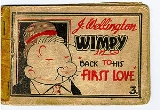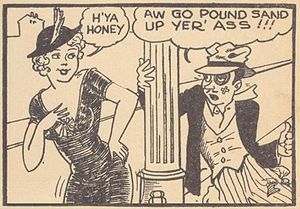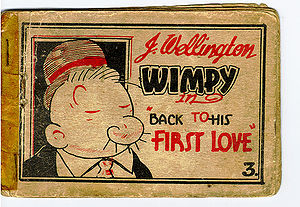
Tijuana bible
Encyclopedia

Pornography
Pornography or porn is the explicit portrayal of sexual subject matter for the purposes of sexual arousal and erotic satisfaction.Pornography may use any of a variety of media, ranging from books, magazines, postcards, photos, sculpture, drawing, painting, animation, sound recording, film, video,...
comic book
Comic book
A comic book or comicbook is a magazine made up of comics, narrative artwork in the form of separate panels that represent individual scenes, often accompanied by dialog as well as including...
s produced in the United States
United States
The United States of America is a federal constitutional republic comprising fifty states and a federal district...
from the 1920s to the early 1960s. Their popularity peaked during the Great Depression
Great Depression
The Great Depression was a severe worldwide economic depression in the decade preceding World War II. The timing of the Great Depression varied across nations, but in most countries it started in about 1929 and lasted until the late 1930s or early 1940s...
era. The typical "bible" was an 8-panel comic strip in a wallet-size 2.5×4 inch format (approximately 7x10.5 cm) with black print on cheap white paper and running eight pages in length. In most cases the artists, writers, and publishers of these are unknown. The quality of the artwork varied widely. The subjects are explicit sexual escapades usually featuring well known newspaper comic strip characters, political figures, or movie stars, invariably used without permission. Tijuana bibles repeated ethnic stereotypes found in popular culture at the time.
History
People distributed Tijuana bibles "under the counter" in places such as schools, garages, cigar stores, burlesque houses, and barber shops as well as from the hatches of station wagons and from persons selling them on the street. The term "Tijuana bibles" refers to the apocryphal belief that they were manufactured and smuggled across the border from Tijuana, Mexico.Renown comic artist and advocate of the medium of comics Art Spiegelman
Art Spiegelman
Art Spiegelman is an American comics artist, editor, and advocate for the medium of comics, best known for his Pulitzer Prize-winning comic book memoir, Maus. His works are published with his name in lowercase: art spiegelman.-Biography:Spiegelman was born in Stockholm, Sweden, to Polish Jews...
notes that records of prosecutions against publishers and artists for making Tijuana bibles do not seem to exist; the cartoonist added, however, that on occasion authorities seized shipments and people selling Tijuana bibles. According to Spiegelman, it's not clear whether mom and pop outfits or organized crime
Organized crime
Organized crime or criminal organizations are transnational, national, or local groupings of highly centralized enterprises run by criminals for the purpose of engaging in illegal activity, most commonly for monetary profit. Some criminal organizations, such as terrorist organizations, are...
created the small salacious booklets. Some sources have suggested that they were created in the back rooms of a few rare book shops which sold erotica under the counter in New York City. In some senses, Tijuana bibles were the first underground comix
Underground comix
Underground comix are small press or self-published comic books which are often socially relevant or satirical in nature. They differ from mainstream comics in depicting content forbidden to mainstream publications by the Comics Code Authority, including explicit drug use, sexuality and violence...
. They also featured original material at a time when legitimate American comic books, typically, still reprinted material from newspaper strips. After World War II
World War II
World War II, or the Second World War , was a global conflict lasting from 1939 to 1945, involving most of the world's nations—including all of the great powers—eventually forming two opposing military alliances: the Allies and the Axis...
, the popularity of the Tijuana bible declined.
Little is known about the anonymous artists who produced the Tijuana bibles. Wesley Morse
Wesley Morse
Wesley Morse was a cartoonist who is most famous for his creation of the Bazooka Joe comic strip for the bubble gum company Topps in 1953...
(who later went on to draw Bazooka Joe
Bazooka Joe
Bazooka Joe is a comic strip character, featured on small comics included inside individually-wrapped pieces of Bazooka bubblegum. He wears a black eyepatch, lending him a distinctive appearance...
) is believed to have drawn many of those appearing shortly before WWII, most notably several titles inspired by the 1939 World's Fair. A number of books have alleged that the freelance cartoonist Doc Rankin
Doc Rankin
Ainsworth H. "Doc" Rankin was an American army officer and freelance cartoonist. He served for many years as an editorial page cartoonist for the Brooklyn Eagle and is best known for producing the touring show This is the Army with Irving Berlin, which toured military camps during World War II...
might have been the creator of numerous Tijuana bibles in the 1930s, although this remains unproven. Collectors have assigned names to several anonymous artists with recognizable styles: "Mr. Prolific" (the creator of the "Adventures of a Fuller Brush Man" series, sometimes said to have been Rankin), "Mr. Dyslexic" (a clumsy, semi-literate artist who produced a number of titles in the postwar period, some with political content), "Blackjack", whose work sometimes resembled linoleum block prints, and "Artist No. 4", an early and witty creator of the 1930s who rivaled Mr. Prolific in talent, popularity and productivity Some observers believe that Mr. Prolific and No. 2 were in fact the same artist working in two different styles to vary his output. The byline "Directed by Elmer Zilch" which appears on scores of early Tijuana bibles appears to have been primarily a pseudonym for Mr. Prolific, although other artists may have employed it as well. The name "Elmer Zilch" referred to a fictional character who was the mascot of the humor magazine Ballyhoo
Ballyhoo (magazine)
Ballyhoo was a humor magazine published by Dell, created by George T. Delacorte Jr., and edited by Norman Anthony , from 1931 until 1939, with a couple of attempts to resuscitate the magazine after the war between 1948 and 1954.In common with other magazines of the era it featured a central...
.
Joe Shuster
Joe Shuster
Joseph "Joe" Shuster was a Canadian-born American comic book artist. He was best known for co-creating the DC Comics character Superman, with writer Jerry Siegel, first published in Action Comics #1...
illustrated a Tijuana-bible-styled erotic work called Nights of Horror in the early 1950s; his male characters are strongly reminiscent of Superman
Superman
Superman is a fictional comic book superhero appearing in publications by DC Comics, widely considered to be an American cultural icon. Created by American writer Jerry Siegel and Canadian-born American artist Joe Shuster in 1932 while both were living in Cleveland, Ohio, and sold to Detective...
and some of his female characters resemble Lois Lane
Lois Lane
Lois Lane is a fictional character, the primary love interest of Superman in the comic books of DC Comics. Created by writer Jerry Siegel and artist Joe Shuster, she first appeared in Action Comics #1 ....
.
Most Tijuana bibles were obscene parodies of popular newspaper comic strips of the day, like "Blondie", "Barney Google", "Moon Mullins", "Popeye", "Tillie and Mac", "Boots", "Dick Tracy", "L'il Orphan Annie", "Betty Boop", "Dixie Dugan", "Flash Gordon", and "Mutt and Jeff". Others made use of characters based on popular movie stars and sports stars of the day, like Mae West and Joe Louis, sometimes with names thinly changed to (presumably) avoid libel. Before the war almost all the stories were humorous and frequently were retellings in comic strip form of well-known dirty jokes that had been making the rounds for decades.
The total number of distinct stories produced is unknown but has been estimated by Art Spiegelman to be between 700 and 1000. These were endlessly reprinted, redrawn, and pirated, with nearly illegible nth-generation copies circulating decades after the originals were first issued.
In addition to the 8-pagers there were also the more expensive "16-pagers", printed in a larger page size with more pages, and usually more carefully drawn and better printed. These were high-priced and less common than the 8-pagers but showcased the artists' best work.
The scale on which Tijuana bibles were produced can be gauged from the large hauls announced in police seizures. In one November, 1942 raid by FBI agent P.E. Foxworth
Percy E. Foxworth
Percy E. Foxworth served as chief of the FBI's Special Intelligence Service and as principal liaison with British Security Coordination...
and his men on a New York City warehouse and a printing plant in the South Bronx, 8 million bibles were reported seized, and small time businessmen Jacob and David Brotman were arrested along with several associates. According to the FBI four tons of material were ready to ship across the country and 7 tons had gone out recently and were being rounded up at regional distribution centers in Baltimore, Pittsburgh, Cleveland/Akron, and Indianapolis. Jacob Brotman, identified as one of the main players in the Tijuana bible trade in Jay Gertzman's Bookleggers and Smuthounds, had earlier been arrested in a similar raid on a Lower East Side loft reported in the New York City papers in 1936, which produced a large haul of bibles, "readers", pornographic playing cards, and nude photos, along with printing, cutting and binding equipment. During the 1939 World's Fair men selling pornographic booklets on the midway at the fair were trailed to a warehouse near the Brooklyn Navy Yard where David Brotman and an associate were arrested and a cache of 350,000 printed items and photos and 50,000 condoms were seized, along with printing plates. Collectors have estimated that in this period typically 50,000 copies would be produced of a single title, and distributed around the country by an underground network of colporteurs.
In New York City police raids on the business, which were carried out at intervals for decades, were usually at the the instigation of John S. Sumner
John S. Sumner
John Saxton Sumner headed the New York Society for the Suppression of Vice , a New York state censorship body empowered to recommend obscenity cases to the appropriate prosecutors. He served as Associate Secretary of the NYSSV for three years, succeeding founder Anthony Comstock as Executive...
and the New York Society for the Suppression of Vice
New York Society for the Suppression of Vice
The New York Society for the Suppression of Vice was an institution dedicated to supervising the morality of the public, founded in 1873. Its specific mission was to monitor compliance with state laws and work with the courts and district attorneys in bringing offenders to justice. It and its...
, which during the years of its existence closely monitored the trade in pornography in the city.
Cultural references

Watchmen
Watchmen is a twelve-issue comic book limited series created by writer Alan Moore, artist Dave Gibbons, and colourist John Higgins. The series was published by DC Comics during 1986 and 1987, and has been subsequently reprinted in collected form...
, the former Silk Spectre, Sally Jupiter, is briefly shown reading a Tijuana bible featuring her, which was given to her by a fan. She finds it amusing; her daughter Laurie Jupiter, the current Silk Spectre, does not.
Will Eisner
Will Eisner
William Erwin "Will" Eisner was an American comics writer, artist and entrepreneur. He is considered one of the most important contributors to the development of the medium and is known for the cartooning studio he founded; for his highly influential series The Spirit; for his use of comics as an...
features Tijuana bibles in the first pages of his book The Dreamer, though nothing explicit is shown. His protagonist, Billy, a young artist out looking for work, is offered a job illustrating them by a printer and a mafioso
Mafioso
Mafioso may refer to:* Mafioso , a 1962 Italian crime comedy film* Mafioso , a member of an Italian mafia clan* Mafioso rap, a hip hop sub-genre...
. Shocked and incensed, he asks if they are legal. The vignette serves not only to focus conflict between the character's dream and reality, but also between legitimate and illicit comic production. Dejected, Billy says he will think it over. The theme is reminiscent of a real-life episode described by Eisner about his being asked to draw for the publications.
In the Canadian novel, The Apprenticeship of Duddy Kravitz (1959) by Mordecai Richler
Mordecai Richler
Mordecai Richler, CC was a Canadian Jewish author, screenwriter and essayist. A leading critic called him "the great shining star of his Canadian literary generation" and a pivotal figure in the country's history. His best known works are The Apprenticeship of Duddy Kravitz, Barney's Version,...
, the title character sells Tijuana bibles, some featuring Dick Tracy
Dick Tracy
Dick Tracy is a comic strip featuring Dick Tracy, a hard-hitting, fast-shooting and intelligent police detective. Created by Chester Gould, the strip made its debut on October 4, 1931, in the Detroit Mirror. It was distributed by the Chicago Tribune New York News Syndicate...
, to his high school classmates, after buying them in bulk from a newsstand vendor who assigns him a small part of the city as his sales territory.
In the novel Water for Elephants
Water for Elephants
Water for Elephants is a historical novel by Sara Gruen. Gruen originally wrote the novel as part of National Novel Writing Month.- Plot :...
, the term "eight-pager" is mentioned in several different locations, one of these when Kinko the dwarf is caught by Jacob Jankowski masturbating while reading a Popeye the Sailor Tijuana bible.
The film The Green Mile
The Green Mile (film)
The Green Mile is a 1999 American drama film directed by Frank Darabont and adapted by him from the 1996 Stephen King novel of the same name...
features a scene in which a prison guard reads a Tijuana Bible that is hidden inside another book.

